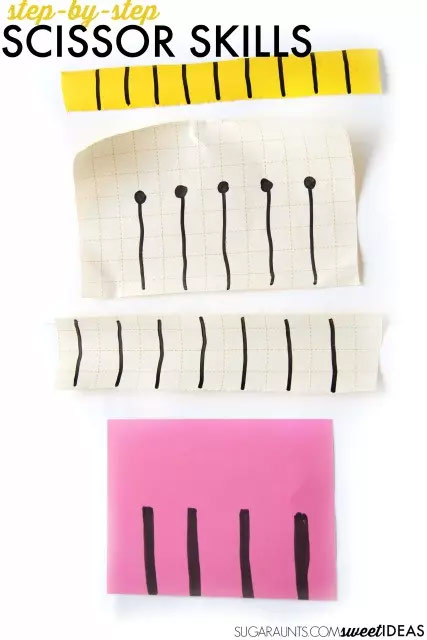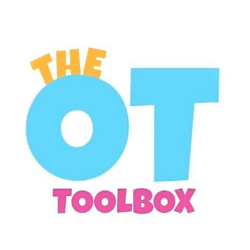Scissor Skills Crash Course
Teaching kids how to use scissors and exploring scissor skills is one of my favorite things to work on as a school-based Occupational Therapist. There are so many creative ways to address the skills needed for accuracy in cutting with a pair of scissors. Today, I’m sharing everything you need to know about cutting with scissors. I’ve got all of the skills a child need in order to be successful. I’ve got great ways to practice teaching your child to cut on lines.
There are many components that go into cutting with scissors. These are the skill that kids need to master or be developing as they pick up a pair of scissors and can cut a shape. Using scissors to cut is a developmental progression of skill. And by that, I mean that as children progress in their development, they achieve more skill and accuracy. Kids need to gain better control of fine motor and visual perceptual skills as they grow and develop and with that development, comes better use of scissors. A child with deficits in any of the skill areas needed for using scissors will have difficulty with progression of typical scissor use development.
In this crash course, I’m going to share the skill components that a child needs to cut with scissors and various steps of cutting accuracy. Not included in this crash course are the developmental ages and stages of scissor use. That blog post will come at another time!
These are the skill areas that a child needs in order to initiate scissor use and develop their progression toward successfully cutting multiple angled shapes:
Fine Motor Skills Needed for Scissor Use: From dexterity to graded precision, using scissors requires fine motor use skills for scissor use.
- Prerequisite skills: Before a child can effectively use scissors in a functional manner, prerequisite skills are essential. These are the functional skills that babies, toddlers, and preschoolers practice and achieve to learn graded muscle movements.
- Open Thumb Web Space: Opening and closing the thumb against the fingers positions the thumb in abduction. Abduction and adduction are required to open and close the scissor’s blades. If a child is not able to open and close their thumb due to physical deficits or weakness, they will not be able to cut with typical scissors. There are many modified versions of scissors out there to assist with this area.
- Hand Strength: Cutting with scissors requires strength. Children may complain of hand fatigue, not be able to cut thick paper such as construction paper, or may cut paper with short snips of the scissors. A gross hand grasp is needed for endurance in scissor use.
- Visual Motor Skills: Also called hand-eye coordination, visual motor skills are our ability to position and use our hands in activities that are guided by our vision.
- Visual Tracking: In order to follow a line with scissors, a person must use visual tracking as they move their scissors along the line. Without this skill, a child will show poor line accuracy and may cut through shapes or across lines multiple times.
- Bilateral Hand Coordination: This is a skill that is required for so many self-care and functional tasks. Using scissors to cut a shape is a functional task that requires both hands working together in a fluid manner. The hands are doing different tasks during the activity of cutting with scissors but both know what the other is doing without the child looking at either hand constantly. This manner of fluid activity is a mechanism of the brain as both hemispheres communicate in an efficient manner. In scissor skill activities, one hand must hold the scissors as the non-dominant hand holds and rotates the paper.
- Hand Dominance: Related to bilateral hand coordination, is hand dominance in scissor use. A child need an established hand dominance in order to develop fine motor skills that are needed for accuracy with scissor use. If a child continues to switch hands, there are scissors that can be used with either hand on the market, however, the child will not develop accuracy and fluid scissor cuts as easily with out an established dominant hand.
Line Accuracy with Scissor Skills: Teaching Kids to cut on the Lines
Line accuracy when cutting with scissors is greatly dependent on position of the hand on the scissors, as well as all of the areas described above. Hand positioning and scissor grasp is a developmental progression and typical tearing of paper happens with certain positions. Typically, a child will developmentally go through certain stages in their scissor skills and as they progress, their accuracy will improve.
Try these scissor practice ideas to work on cutting on the lines. These ideas progress (mostly) from easiest to most difficult.

Providing kids with kid-friendly scissors and paper will help with practice. Kids can practice cutting with scissors as early as you feel comfortable. It’s important to remember that all children develop differently. Hand over a pair of scissors and show the child how to snip into the edge of the paper, without lines or shapes. At this point, the child is only working on the skill areas described above.
A strip of paper is a great starting point for practicing line awareness with scissors. Make the paper strip thin enough that one snip across will cut the paper.
>Next, practice cutting into the paper and along a line. A black dot will provide a visual cue to stop at the end of the line.
Next, provide a strip of paper that is wider and requires several cuts across the page to cut through the line. This activity works on the child’s ability to open and shut the scissors without choppy cuts for several snips. (NOTE: Provide a wider strip of paper than is shown in the above picture for more practice of continued cutting!)
Finally, provide a strip of paper with lines without stopping dots. The child must cut along the lines and stop at the end of the line. These lines are drawn very dark to provide a thicker cutting line, to ensure more accuracy.
When moving on to cutting shapes, start with squares. You can draw the square along the edge of the paper to allow the child to cut into the corners from each side. Then practice cutting a square inside the paper. Cutting shapes requires the paper to be rotated and turned accurately. Practice cutting other straight line shapes like triangles and rectangles.
After practicing straight line shapes, introduce cutting curved shapes.
Another way to practice line awareness with scissors is to cut curved and multiple angled lines across a strip of paper. Add in more complex shapes like stars and hearts.
When starting on more angled or wavier shapes, provide stopping points with black dots. These will act as a visual cue and an indication to turn or rotate the page and move the scissors.Finally, practice cutting multiple-angular and curved line shapes. To start, try drawing a thick black line around the shape to provide a thicker cutting line. Then, remove the visual cue of the line and cut directly on the lines of the shape.
The OT Toolbox, USA

PROFILE
Resources, tools, ideas, and activities designed to support healthy development of kids. Based on function and occupation-centered activities, the tools shared on The OT Toolbox promote the underlying skills needed for action and performance in kids.
Colleen is an occupational therapist with many years in the field, who promotes the healthy development of kids through play, movement in order to make a positive impact on kids today.
Main Research Source
- Scissor Skills Crash Course (with Gift Wrap!)(29/01/2016)
